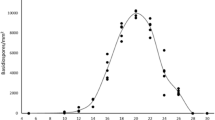Abstract
A new grapevine leaf rust (GLR) was found to be caused by Phakopsora montana. This new fungus naturally infects Crimson Glory vine (Vitis coignetiae), forming uredinia and telia on the leaves. Under experimental conditions, the fungus was pathogenic to table grape cultivars Delaware and Kyoho (V. × labruscana), Amur River grape (V. amurensis), and V. ficifolia, on which it produced urediniospores. Inoculation experiments proved that the pathogen alternates hosts, forming spermogonia and aecia on Meliosma tenuis. The new pathogen resembles P. meliosmae-myrianthae (=P. euvitis), a common GLR fungus; however, its spermogonial/aecial stage is restricted to M. tenuis, contrary to P. meliosmae-myrianthae with its spermogonial/aecial stage restricted to M. myriantha. Aeciospores of the new pathogen are evenly thin-walled, whereas the aeciospore wall is conspicuously thickened apically in P. meliosmae-myrianthae. Phakopsora montana is known to occur only on V. coignetiae in nature; however, table grape cultivars Delaware and Kyoho were not resistant to P. montana under experimental conditions. These results indicate that P. montana has caused a certain proportion of the GLR disease recorded in Japan with a possible mixed infection with P. meliosmae-myrianthae.




Similar content being viewed by others
References
Anonymous (2008) 10 top reasons: why tropical viticulture and hot climate winemaking is rapidly progressing 1980–2008. Tropical Viticulture Consultants LTD & CoKG. http://www.monsoonvalleywine.com/download/10Reasons.pdf (cited 10 April 2012)
Buriticá PC (1994) Cambios taxonomicos y nuevos registros de Uredinales de la flora Andina. Rev Inst Cien Nat Ecol 5:173–190
Buriticá PC (1999) La familia Phakopsoraceae en el Neotrópico III, géneros: Batistopsora y Phakopsora. Rev Acad Colomb Cienc 23:271–305
Chatasiri S, Ono Y (2008) Phylogeny and taxonomy of the Asian grapevine leaf rust fungus, Phakopsora euvitis, and its allies (Uredinales). Mycoscience 49:66–74
Chatasiri S, Kitade O, Ono Y (2006) Phylogenetic relationships among Puccinia hemerocallidis, P. funkiae, and P. patriniae (Uredinales) inferred from ITS sequence data. Mycoscience 47:123–129
Clayton CN, Ridings WH (1970) Grape rust, Physopella ampelopsidis, on Vitis rotundifolia in North Carolina. Phytopathology 60:1022–1023
de Souza NS (2004) Occurrence of grape rust in the State of Mato Grosso, Brazil (in Portuguese with English abstract). Fitopatol Bras 29:226
Giraud T, Gladieux P, Gavrilets S (2010) Linking the emergence of fungal plant diseases with ecological speciation. Trend Ecol Evol 25:387–395
Giraud T, Refrégier G, Le Gac M, de Vienne DM, Hood ME (2008) Speciation in fungi. Fungal Genet Biol 45:791–802
Hawksworth DL (2011) A new dawn for the naming of fungi: impacts of decisions made in Melbourne in July 2011 on the future publication and regulation of fungal names. MycoKeys 1:7–20
Hiratsuka N, Sato S, Katsuya K, Kakishima M, Hiratsuka Y, Kaneko S, Ono Y, Sato T, Harada Y, Hiratsuka T, Nakayama K (1992) The rust flora of Japan. Tsukuba-shuppankai, Tsukuba
Jackson AP (2004) A reconciliation analysis of host switching in plant–fungal symbioses. Evolution 58:1909–1923
Kudo A, Kaneko S (1977) Parasiticity of Aecidium meliosmae-myrianthae to grapes (abstract in Japanese). Ann Phytopathol Soc Jpn 43:322
Kudo A, Kaneko S (1978) Heteroecism of grape rust fungus (abstract in Japanese). Ann Phytopathol Soc Jpn 44:375
Norvell LL (2011) Fungal nomenclature. 1. Melbourne approves a new Code. Mycotaxon 116:481–490
Okada G (2011) Unified nomenclature for anamorphic fungi or fungi with a pleomorphic life cycle adopted at the 18th International Botanical Congress (IBC2011, Melbourne) (in Japanese). Jpn J Mycol 52:82–97
Ono Y (1994) Tranzschelia asiatica sp. nov. and its taxonomic relationship to Tranzschelia arthurii. Can J Bot 72:1178–1186
Ono Y (2000) Taxonomy of the Phakopsora ampelopsidis species complex on vitaceous hosts in Asia including a new species P. euvitis. Mycologia 92:154–173
Ono Y (2003) Does Puccinia hemerocallidis regularly host-alternate between Hemerocallis and Patrinia plants in Japan? J Gen Plant Pathol 69:240–243
Ono Y (2005) Plantainlily rust fungus is distinct from daylily rust fungus. J Gen Plant Pathol 71:99–106
Ono Y (2008) Why life-cycle studies?: implications in the taxonomy of rust fungi (Uredinales) (in Japanese with English abstract). Nippon Kingakukai Kaiho 49:1–28
Ono Y, Azbukina ZM (1997) Heteroecious life cycle of two graminicolous Puccinia (Uredinales). Mycoscience 38:281–286
Peever TL (2007) Role of host specificity in the speciation of Ascochyta pathogens of cool season food legumes. Eur J Plant Pathol 119:119–126
Pota S, Chatasiri S, Ono Y, Yamaoka Y, Kakishima M (2013) Taxonomy of two host specialized Phakopsora populations on Meliosma in Japan. Mycoscience. doi:10.1016/j.myc.2012.07.004
Rice WR (1984) Disruptive selection on habitat preference and the evolution of reproductive isolation: a simulation study. Evolution 38:1251–1260
Roy BA (2001) Patterns of association between crucifers and their flower-mimic pathogens: host jumps are more common than coevolution or cospeciation. Evolution 55:41–53
Rundle HD, Nosil P (2005) Ecological speciation. Ecol Lett 8:336–352
Satake Y, Hara H, Watari S, Tominari T (1989) Wild flowers of Japan. Woody plants II (in Japanese). Heibonsha, Tokyo
Shear CL (1924) Grape rust in Florida. Phytopathology 14:170–171
Szabo LJ (2006) Deciphering species complexes: Puccinia andropogonis and Puccinia coronata, examples of differing modes of speciation. Mycoscience 47:130–136
Tessmann DJ, Dianese JC, Genta W, Vida JB, May-de Mio LL (2004) Grape rust caused by Phakopsora euvitis, a new disease for Brazil. Fitopatol Bras 29:338
Weinert MP, Shivas RG, Pitkethley RN, Daly AM (2003) First record of grapevine leaf rust in the Northern Territory, Australia. Australas Plant Pathol 32:117–118
Acknowledgments
This study was supported, in part, by a Grant-in-Aid for Scientific Research No. 18570081 from the Japan Society for the Promotion of Sciences (YO). The type material of Aecidium meliosmae-myrianthae was loaned from the mycological herbarium, Botanic Gardens and Museum Berlin Dahlem (B), for which we are grateful. SP expresses heartfelt thanks to Prof. Makoto Kakishima for his guidance in graduate studies at the University of Tsukuba. The authors declare no conflict of interests. All the experiments undertaken in this study comply with the current laws of Japan.
Author information
Authors and Affiliations
Corresponding author
Rights and permissions
About this article
Cite this article
Ono, Y., Chatasiri, S., Pota, S. et al. Phakopsora montana, another grapevine leaf rust pathogen in Japan. J Gen Plant Pathol 78, 338–347 (2012). https://doi.org/10.1007/s10327-012-0401-y
Received:
Accepted:
Published:
Issue Date:
DOI: https://doi.org/10.1007/s10327-012-0401-y




